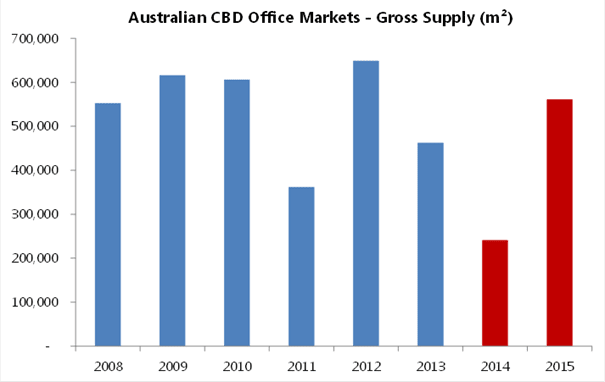Australian CBD office supply forecast to hit 13 year low
Australian CBD office markets are entering into a hiatus period this year, with supply levels forecast to hit their lowest point in 13 years.
Despite strong supply in Melbourne and Sydney, Knight Frank's latest Australian CBD Research showed that stock levels across the nation's capital cities slumped 29% to 463,000 square metres of new and refurbished stock in 2013. That compared to 649,000 square metres in 2012.

Source: Knight Frank
Supply levels are expected to shrink further this year, with the global real estate firm forecasting supply to come in at only 241,000 square metres - a figure it says would be the lowest level of gross supply additions since 2001 when nearly 200,000 square metres was completed.
"Following relatively strong completion activity over the past two years, this hiatus in new construction completions over the next 12 months comes at a welcome time for the markets, especially those with an overhang of backfill and sub-lease space waiting to be absorbed," said Knight Frank national director of research, Matt Whitby.
This year, he said, the only major high profile additions to stock would occur in Melbourne, with 150 Collins Street (Westpac committed) and 720 Bourke Street (Medibank committed) slated for completion. A handful of smaller new builds and refurbishments would also be completed in Sydney, Perth and Adelaide, he added.
However, Knight Frank is projecting a rebound of supply in 2015. It is tipping completions to total about 562,000 square metres and includes projects that commenced without tenant pre-commitments such as 180 Ann Street, Brisbane (Daisho) and 20 Martin Place, Sydney (Pembroke).
"Notwithstanding this, Brisbane and Canberra will be devoid of any major supply until late 2015," said Mr Whitby.
He also made a point of saying that while new supply additions were expected to be relatively lower, backfill space would continue to be a major factor this year and increasingly so during 2015.
Another key theme cited in the report was last year's unprecedented level of site sales occurring in and adjacent to the CBD markets, mostly in Melbourne and Sydney. That demand, said Mr Whitby, was driven predominately by Asian developers, as the "highest and best use" of sites was, and continues to be, slanted towards residential rather than commercial use.
"This trend will see an increasing amount of commercial stock withdrawn due to residential and hotel conversions, alongside a large number of obsolete stocks being refurbished and modernised in an effort to attract tenants."
He described that as a "real game changer for markets", especially in Sydney and Melbourne over 2014/15, "as the net supply figures (i.e. after withdrawals) will be significantly lower than the headline numbers, which will help cushion the market in the face of a soft leasing market."